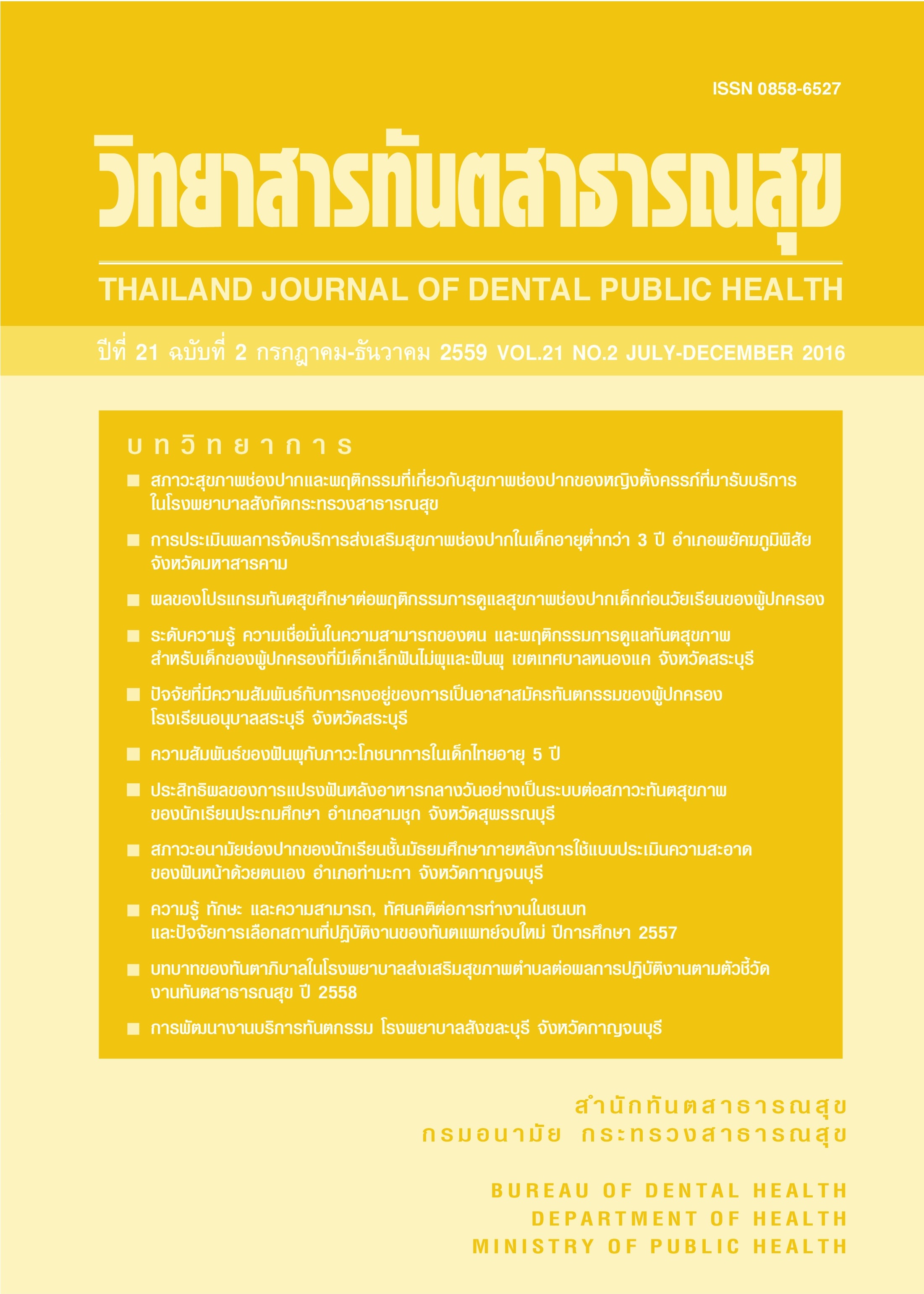Factors Related to Performance Existence as Parents’ Dental Health Volunteers at Anuban Saraburi School, Saraburi Province
Main Article Content
Abstract
The objective of this descriptive research was to study factors that related to the exist of parents dental health volunteers of Anuban Saraburi School. All volunteer parents in academic year 2015 filled up self assessment questionnaire and returned via class teacher between January to March 2016. The data were analyzed by descriptive statistics (percentage, mean and standard deviation) and analytical statistics (Chi-Square test, Pearson’s correlation coefficient) at significant difference level of p≤ 0.05. Results showed that all 127 volunteers of which 93.7 percent were female, average age 39.8 years, majority had Bachelor Degree or higher, house-wife, with monthly income higher than 15,000-50,000 Baht, married status and being volunteers average 1.4 years. Motivating factor (benefit) was positively correlated to the existence as parent dental health volunteers at a personal level (willingness to work as a volunteer continuing). Maintain factors (policy and administration of volunteer’s network, working conditions and job security) were negatively correlated to the existence as parent dental health volunteers at a personal level (willingness to work as a volunteer continuing) and maintain factors (policy and management of volunteer’s network) also negatively correlated to performance existence as parents’ dental health volunteers at both person and network level. Supportive factor (support from the various stakeholders) was positively correlated to performance existence as parents’ dental health volunteers in network level (satisfied with the system network). This relationship was a low correlation (r = .175-.237).
Downloads
Article Details
References
2. Coots, J.J. (1998, Win). “Family resources and parent participation in schooling activities for their children with developmental delays”. Journal of Special Education, 31(4): 498-520.
3. Louise, W.T. (1998, June). “Parental perceptions of current and ideal levels of family participation in early intervention program practices in lllinois (Parent involvement).”
Dissertation Abstracts Program International,58(12) : 4551-A.
4. Westmoreland, Helen. (2009). Family Involvement Across Learning Setting. Harvard Family Research Project.Retrieved August 17, 2009, from:http://www.hfrp.org
/familyinvolvement/publications-resources/ family- involvement-across-learning-settings.
5. สุวัชพานิชวงษ์. (2546). การมีส่วนร่วมของผู้ปกครองนักเรียนในการส่งเสริมการเรียนรู้ของนักเรียนในเขตอำเภอเมืองสุพรรณบุรีจังหวัดสุพรรณบุรี. (วิทยานิพนธ์ปริญญามหาบัณฑิต) มหาวิทยาลัยศรีนครินทรวิโรฒ, กรุงเทพมหานคร.
6. Epstein, J.L.et al. (1997). School, family, community partnerships: your handbook action. Thousand Oaks: Corwin Press.704.
7. วราภรณ์ ศิริสว่าง. (2542). อนามัยโรงเรียนทฤษฎีและการปฏิบัติ.เชียงใหม่: นพบุรีการพิมพ์.
8. Daniel, U.L. &Rayna, F.L. (1996). Home Environment, The Family and Cognitive Development Society and Education. (9th ed.). New York: Simon & Schuster.
9. วิวรรณ สารกิจปรีชา. (2554). การศึกษาความสัมพันธ์ระหว่างคุณลักษณะของผู้ปกครองกับพฤติกรรมการมีส่วนร่วมของผู้ปกครองในการส่งเสริมการเรียนรู้ของนักเรียนโรงเรียนอนุบาลกุ๊กไก่เขตคลองเตยกรุงเทพมหานคร.(วิทยานิพนธ์ปริญญาการศึกษามหาบัณฑิต) มหาวิทยาลัยศรีนครินทรวิโรฒ, กรุงเทพมหานคร.
10. เกตุสุเดช กำแพงแก้ว. (2547). การศึกษากิจกรรมการมีส่วนร่วมของผู้ปกครองในการจัดการศึกษาของโรงเรียน: กรณีศึกษาโรงเรียนอัสสัมชัญ แผนกประถม.(ดุษฎีนิพนธ์การศึกษาดุษฎีบัณฑิต) มหาวิทยาลัยศรีนครินทรวิโรฒ, กรุงเทพมหานคร.
11. กลุ่มงานทันตกรรม โรงพยาบาลสระบุรี. (2548). เอกสารทส.003โรงเรียนในเขตอำเภอเมืองสระบุรี จังหวัดสระบุรี.
12. กลุ่มงานทันตสาธารณสุข สำนักงานสาธารณสุขจังหวัดสระบุรี. (2548). เอกสารผลการสำรวจ พฤติกรรมการบริโภคน้ำตาลในกลุ่มเด็กนักเรียนประถมศึกษา จังหวัดสระบุรี.
13. เอกสารผลงานเครือข่ายอาสาสมัครทันตกรรมเพื่อการประกวดรางวัลไลอ้อนส์เพื่อสุขภาพช่องปาก.โรงเรียนอนุบาลสระบุรี. (2556).
14. Herzberg, F. (1959). TheMotivation of Work. New York:JohnWiley&Sons.Herzberg, F. (1987). One More Time: How do You Motivate Employees?.Harvard Business Review. Retrieved October 3, 2012 from:http://numerons.files.wordpress.com/2012/04/how-do-you-motivateemployees-frederick-herzberg.pdf
15. Pilisuk, M. (1982). Delivery of Social Support: The Social Innovation. American Journal of Orthoppsychiatry,52(January), 20.
16. House, R,, Rousseau, D. M.,& Thomas–Hunt, M. (1995). The Meso paradigm: A framework for the integration of micro and macro organizational behavior. In Cummings, L. L. &Staw, B. M. (Eds.), Research in Organizational Behavior. Greenwich: JAI Press.71-114.


